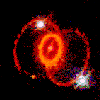Scientists can't detect it, nor do they know exactly how much there is
out there, but dark matter could be the link to satisfy the missing mass
in critical density. Dark matter could be neutrinos, gas, black holes,
or something we can not even fathom. Neutrinos are released
from a supernova as byproducts of
its collapsing core. They are thought to have little or no mass,
less than .0001 times the mass of an electron. They are also very
difficult to detect, neutrinos rarely interact with regular matter.
Theoretically, "a neutrino mass of 1 eV would provide the critical density
implied by the observed expansion of the Universe." (Zita, seminar
paper #2, Ferris's The Whole Shebang) 1 eV is all that is required,
because neutrinos are so abundant in the Universe.
This can be checked through some
quick equations.
How massive must neutrinos be if
they provide most of the dark matter to close the Universe (Omega=1)?
Ignoring bright matter (which is 10%
of critical density), heavier neutrinos (muon and tau), and baryonic
matter (black holes, neutron stars, and white dwarfs), we shall assume
only neutrons will make up the missing matter for critical density.
1) There are the same amount of neutrinos
as primordial photons: about 108 times the number of baryons
(protons and neutrons). The number3 of neutrinos (or photons)
per cm3 is then about 45,000. That is, number density
of neutrinos=Pv is about equal to 4.5 x 1010 neutrinos/m3
2) Critical density is p=10-26
kg/m3
We can find the required mass of neutrinos
by comparing the mass density (p) of a closed Universe with the number
density Pv of neutrinos:
Mv (mass of neutrinos)=
p = 10-26
kg/m3
=
1 10-36
kg
Pv 4.5 x 1010neutrinos/m3
Next, translate the neutrino mass into
the common energy units used for particles.
Mvc2 =(
1/2 10-36 kg)( 3 x 108 m/s)2
= 3 x 10 17-36 kg
m2 x
eV
This is within the boundaries for the mass of the neutrino.
(Zita, Seminar paper #2: Ferris's The Whole Shebang,
Ch 4-5, Appendix : Neutrino mass and critical density) (3
Barry Parker, Invisable matter and the Fate of the Universe,
Plenum 1989, p.142)
Time to dust off an old theory............
Dark matter
is not the only possibility to settle the critical density problem.
Research from the High-Z Supernova project suggest that the Universe is
actually accelerating outward. This has led scientists to dust off
Einstein's theory of a cosmological constant. (Glanz,
Science, Oct. 31, 1997)
Not long
after Einstein developed his theory of relativity in 1915, he discovered
that it demanded that the Universe either expanded or contracted over time.
He assumed like many scientists of his time that the Universe was static.
(Wilford, New York Times Late Edition, March 3, 1998).
Feeling
that he had made an error, Einstein attempted to compensate for the problem
with the idea of a cosmological constant. A repulsive force to counteract
gravity, Einstein symbolized the cosmological constant by the Greek letter
lambda. (Glanz, Science, Oct. 31, 1997) In 1929, Hubble discovered
that the Universe really wasn't static after all, and this caused Einstein
to drop the cosmological constant from his equations, calling it the biggest
blunder of his career. (Wilford, New York Times Late Edition, March
3, 1998)
In 1990,
Dr. Michael S. Turner, an astrophysicist at the University of Chicago and
Fermi National Laboratory, came up with a formula for a "best fit Universe"
in keeping with inflation theory. He figured "5 percent ordinary
matter and 25 percent mass in the form of cold, dark matter." (Wilford,
NYT) The antigravity force, or the cosmological constant, would account
for the other seventy percent, bringing the Universe up to critical density.
Dr. Adam
Riess, of the High-Z Supernova group and Alexei V. Fillipenko, have reviewed
their findings to support a cosmological constant, yet still haven't found
any errors to doubt their findings. On February 18, 1998, "Dr. Fillipenko
informed colleagues at a meeting in Marina Del Rey, California that 'We
(The High-Z Supernova group) got a nonzero cosmological constant.'"
(Wilford, New york Times, Late Edition,
March 3, 1998) If their findings prove true, this would mean our
universe was once expanding more slowly than it is now, and it would put
our Universe's age at 14 billion years, or a billion years older than the
oldest known stars.
So, How do they figure out
the fate of the Universe?
Now
that we 've presented the Universe expansion theories, how are astrophysicists
trying to find an answer to the fate of our Universe? Because of
recent technologies, The Supernova Cosmology Project and the High-Z Supernova
group are able to make considerable progress finding Type Ia supernovae
in distant galaxies that help to fortell the future of the Universe.
(Glanz, Science, Oct. 31, 1997)
Since 1993, a technique used by the Supernova Cosmology Project has been
extremely effective in finding distant supernovae. (A more updated
and sensitive version of the same technique is used today.) The experiments
have only become possible recently, because they involve using the latest
technology in computers, the internet, and the largest telescopes in the
world. "An ultra-sensitive electronic camera attatched to a
telescope is used to photograph thousands of deep space galaxies at the
same time of a new moon. A second set of those same galaxies is taken
at the same telescope just before the new moon. Using a computer,
the two sets of images are compared, and the light from the older image
is subtracted from the new image to reveal the appearance of supernovae."
(Yarris, Berkeley Lab, Jan 16, 1996) The most recent supernovae were
spotted with the Cerro-Tololo Inter-American Observatory 4-meter telescope
located in Chile. The WIYN telescope on Kitt Peak, AZ deals with
brightness measurements, as well as the ARC telescope at Apache Point,
NM. The 4 meter and 2.5 meter telescopes at the Canary Islands and
the Anglo-Australian 4-meter telescope in Australia both measure supernovae
as they start to fade away. (Hubble Space News, Jan. 8, 1998)
Supernova Cosmology teammate Greg Aldering: "We are studying cosmic
fireworks that fade within weeks, so we have to move fast." (Hubble
Space News, 8 Jan 1998) The team springs into action: while some
members are looking for supernovae at the CTIO, others are in Berkeley
getting that information off of the internet and analyzing it for supernovae.
At the same time, members are rushing to the Keck 10 meter telescope in
Hawaii to confirm that the objects are supernovae and (if they are), the
team members proceed to measure the supernovae redshifts. (The Keck
was especially designed by the Berkeley Lab to look for distant celestial
objects, such as supernovae.) (Wilford, NYT) The Hubble Telescope
is used to keep track of the supernova when it becomes too faint for ground
telescopes to see anymore. The Hubble is a much better instrument
to use in measuring light curves because atmospheric dust doesn't get in
the way, and observers don't have to worry about an atmosphere scattered
with moonlight, as they would have on a ground based telescope. Hubble
also makes it easier to separate the light of a supernova from the shine
of its host galaxy. (Glanz, Science,
Oct. 31, 1997)
After the process of finding a supernova, confirming it, and analyzing
its redshift (wavelengths stretched by the expansion of the Universe),
scientists can compare that to bright, nearby supernovae to determine the
distance that the light from the distant supernova has traveled.
Compared with the Hubble Constant, astrophysicists can determine the fate
of our Universe. (Hubble Space News, Jan. 8, 1998)
At no other time in history have scientists been so close to discovering
the fate of the Universe. Primed with Hubble's law, the Big Bang
Theory, and Einstein's theory of relativity, scientists are in an excellent
position to answer the question: How will our Universe end?



 OR........
OR........
